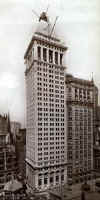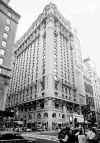|
New York Architecture Images-New York Architects Trowbridge & Livingston |
||||
| New York works; | ||||

|

|
 |
 |
|
| 035 MORGAN GUARANTY TRUST BUILDING | 046
St.Regis-Sheraton Hotel |
161 The B. Altman Department Store | ||
|
Samuel Beck Parkman Trowbridge
(1862-1925) was born in New York City, son of William Petit and Lucy
Parkman Trowbridge. At the time of his birth, Trowbridge's father, whose
initial career was in the military, was the superintending engineer of
the construction of Fort Totten Battery, repairs to Fort Schuyler, and
work at Governor's Island. The work was being done to fortify the city
against possible attack during the Civil War. After the War, he left the
military and eventually became professor of dynamic engineering at Yale.
From 1877 until his death in 1892, he was professor of engineering at
the Columbia School of Mines. Undoubtedly, the younger Trowbridge was
influenced in his choice of career by his father's profession. After his early education in the city's public schools, Trowbridge did his undergraduate studies at Trinity College in Hartford. On graduating in 1883, he entered Columbia's School of Mines, and later furthered his training at the American School of Classical Studies in Athens and at the Ecole des Beaux-Arts in Paris. On his return to New York, he entered the office of George B. Post. In 18914, he, Goodhue Livingston and Stockton B. Colt formed a partnership that lasted until 1897 when Colt left and the firm became Trowbridge & Livingston. Goodhue Livingston (1867-1951), a descendant of a prominent colonial New York family, received his undergraduate and graduate degrees from Columbia during the same period Trowbridge was at the school. Their partnership was to be a long and productive one. The firm is best known for its public and commercial buildings, which, besides B. Altman, include the St. Regis Hotel (1904) at Fifth Avenue and 55th Street; Engine Company 7, Ladder Company 1 (1905) at 100 Duane Street; the banking headquarters of J.P. Morgan (1913) at 23 Wall Street; the 1923 extension to the New York Stock Exchange at 11 Wall Street; the Oregon State Capitol (1936-38), designed in association with Francis Keally; and the Hayden Planetarium (1935) of the American Museum of Natural History at West 81st Street and Central Park West. |
||||
|
links |
||||